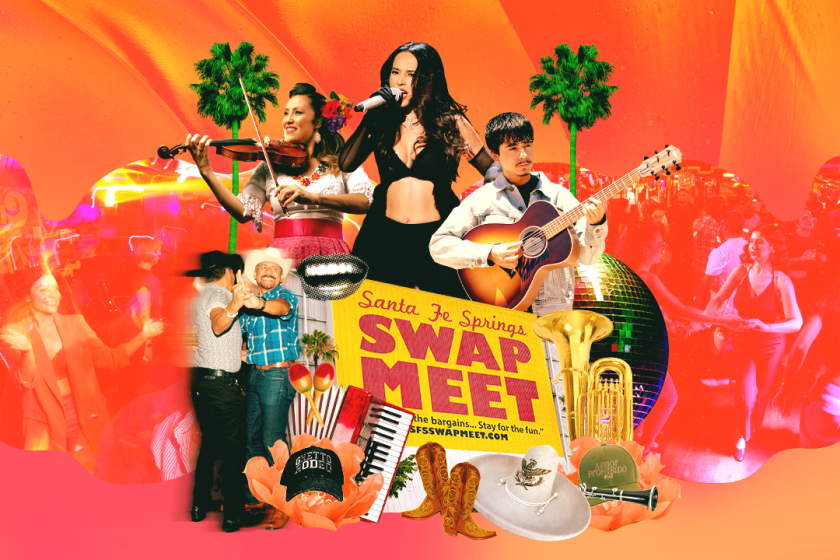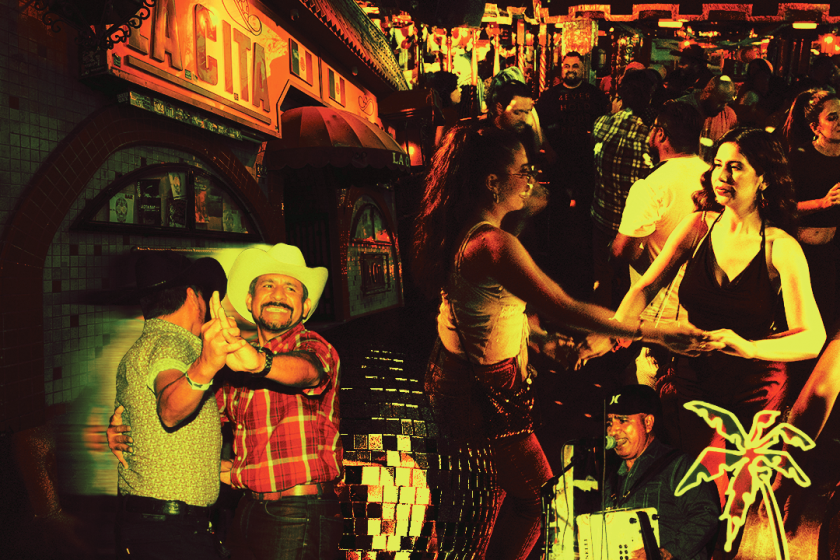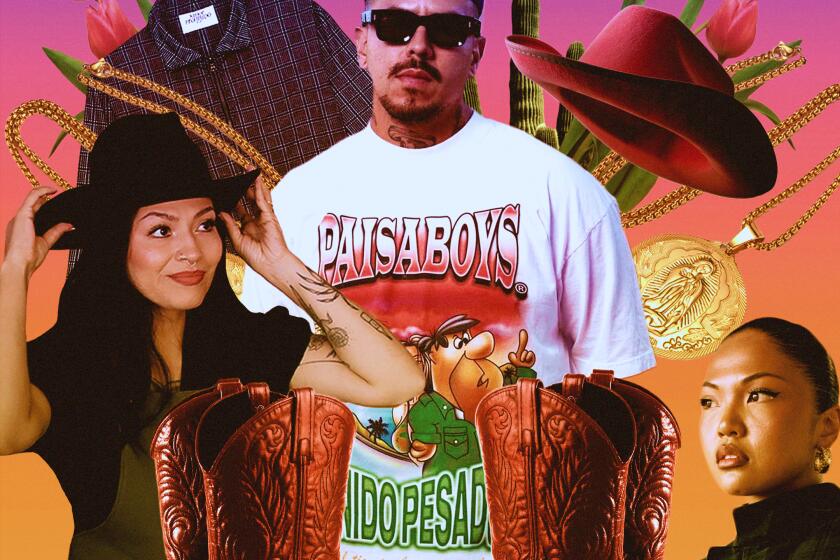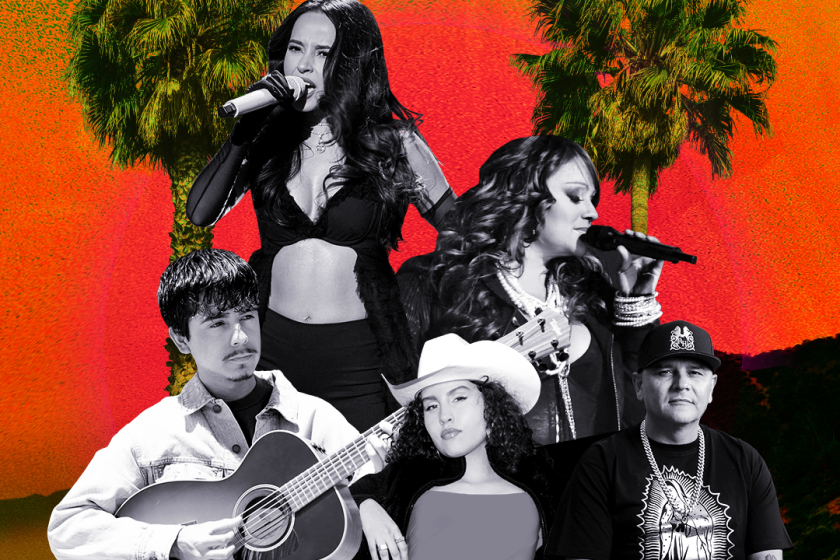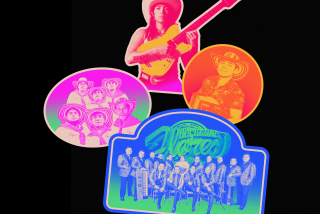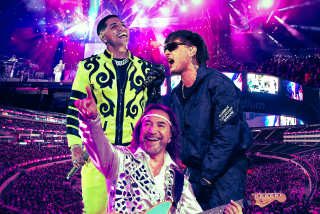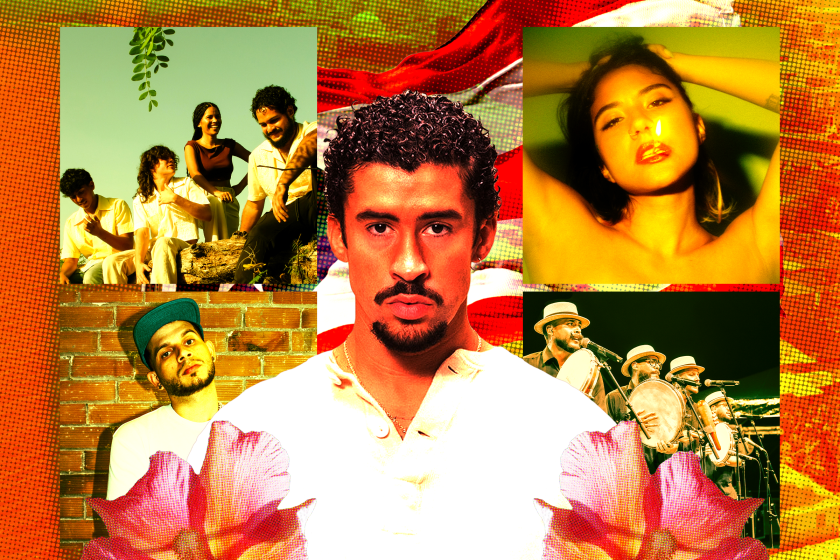
- Share via
On most Thursdays, Danny Ramirez begins his weekly routine: a fresh haircut, beard trim and boot shining. But he isn’t prepping for a date or a night out with friends.
It’s all part of the 31-year-old’s ritual before he heads to the weekend bailes, or Mexican dance gatherings, where it’s his job to bring dancers to the floor with dizzying norteño moves in a whirl of cheek-to-cheek embraces with random partygoers. The Sylmar-based TikTok influencer is part of a growing spectacle in the culture of bailes, attracting new and young crowds with his gliding footwork.
Música Mexicana has been pushed into the mainstream over the last five years by Gen Z and millennial Latino audiences. Here’s a guide on the genre’s essential instruments, where to find the best música Mexicana-themed parties, where to shop for the perfect vaquero outfit and more.
“We are there to lift the atmosphere,” Ramirez said.
At venues across the country, women line up to dance with Ramirez, whose hypnotic partner-twirling to Norteño-sax music has garnered the former construction worker more than half a million TikTok followers, mainly eager young dancers looking to acquire new moves.
As dance clubs and studios hope to lure some of their massive social media followers to their venues, these baile influencers are getting the same star treatment as the norteño or banda act of the night, oftentimes appearing alongside performers on the promotional fliers.
“There’s many people who follow us to different cities,” Ramirez said. “In a way, we give people another reason to attend these events.”
It’s still a pinch-me moment for Ramirez, a musical theater lover and former competitive cheerleader who moved to the U.S. three years ago from Zacatecas, Mexico, in search of a better life. Since dedicating himself full-time to content creation, he has become a dance star of sorts, with club promoters flying him out to bailes in more than 25 states, including Kansas, Tennessee and South Carolina.
“I hope that our movement can touch every corner of the U.S. so that our community feels proud of our Mexican culture,” said Ramirez.
That has been the case for venues such as the Palacio Event Center in New Castle, Del., that are known for booking influencers to draw dancers to their bailes in a state where Latinos make up less than 10% of the total population.
In the mood to spend the night dancing to a live norteño band? Or maybe enjoy a michelada while listening to a música Mexicana DJ? Here are the best places to indulge in L.A.’s best regional Mexican venues.
“I started seeing that there were people that got tremendous amounts of attention on social media,” said Edwin Velasco, marketing promoter at the Palacio Event Center.
Velasco, who studied business administration in college, wanted to fill the dance hall. After seeing other nearby venues sell out on nights where they brought in social media personalities, he decided to reach out to popular influencers and began promoting them on the same flashy fliers displaying the main norteño or banda act of the night.
“Once we started bringing the influencers, we started noticing younger crowds,” said Velasco, 24. “I actually see a lot of my friends come out with their parents. It’s fun.”
According to a 2023 study by Live Nation, social media fuels fan interest, with approximately 90% of live music-goers agreeing that seeing live music content on social media makes them want to attend shows. Snapping a picture with a famous TikTok dancer while listening to a live norteño band feels like an added bonus to baile attendees.
“It’s like bringing a small celebrity to a club,” said Velasco. “These guys get hundreds and millions of views, and people want to see them.”
Jasmin Goodwin had never attended a baile before 2021, but as a trained dancer, she picked up the steps quickly. She slowly carved out more than 705,000 TikTok followers and distinguished herself by flashing her white smile on camera and wearing glittery outfits. Norteño dancers tend toward a more serious face and less flashy western attire.
But the idea of flying out to venues to promote weekend bashes was initially daunting to the L.A. local, who had a steady job as an assistant bank manager and saw her social media videos as just a hobby.
Whether you’re in the market for a custom-fit tejana, a show-stopping pair of boots or even a new matching set, these places bring both a fresh and a classic feeling to shopping.
“It was a new thing where [venue promoters] were flying out people from other states to these bailes,” said Goodwin. “I’m not going to be missing work for this.”
However, after embarking on weekend getaways to venues in Florida and Illinois, she quickly paid off her car loan, prompting the 27-year-old to quit her bank job. She’s been booked every weekend since.
Those confident enough to lead her on the dance floor, some of whom have been children, often record videos of the sessions and post them on their own social media for views and likes.
“A lot of the younger crowd has social media like TikTok, and I feel like [we‘ve] inspired them to start going out to the bailes,” she said.
It’s refreshing for Goodwin, who still recalls how embarrassed her chambelanes were to dance at her quinceañera. Now, she’s noticed an uptick in the huapango dance, a faster and bouncy norteño groove with an alternating two-step and an occasional hip roll that can be done paired or solo — which she has mastered.
“It’s a healthy hobby,” Goodwin said. “It keeps them out of the streets. It keeps them from being at home on their electronics, watching TV and being potatoes.”
David Cruz, owner of Fairytale Dance, a Santa Fe Springs quinceañera choreography studio founded in 2008, believes social media influencers are setting the tone for the new era of baile culture.
“Whatever style influencers are showing in their video is the style that people want to copy,” Cruz said.
The dance instructor started hosting free weekly huapango classes this year for teens to meet growing community interest. With the majority of his quinceañera clients requesting choreography for huapangos, tribal or banda, he also uses this tutorial to scout male chambelanes as prospective dancers for his company.
It’s a nostalgic moment for the 38-year-old, who was brought up during the quebradita hype that spread through Southern California dance floors in the early 1990s with a series of back-breaking bends and snake-like footwork, elements that have been rekindled in recent years as youths seek to individualize their style.
“A bunch of these teens are posting themselves dancing to huapango, going to jaripeos,” Cruz said. “Kids are now wearing their botas to school or their tejanas and starched jeans.”
In the region known for bumping música Mexicana genre into the global mainstream, Southern California is the birthplace for some of the most popular acts.
When he was 7, Cruz was in a dance crew, El Sheriff de Chocolate, named after the Bronco-inspired song about an immersive candy universe. On weekends, Cruz would show off his spins or springs against other quebradita crews, each with its own dance style and dress code, at homes, halls and warehouses across Los Angeles and Orange counties.
“I used to make fun of people who liked banda music,” teen Ricardo Contreras said in a 1994 Times interview. “But then I went to one party, saw all the pretty girls, and then went out and bought myself the boots and the hat.”
The romantic allure has persisted through time and on the dance floor, Cruz suspects. If dancers can swirl their partner correctly, maybe they can swoon them too.
“With these styles, there’s a chance that [teens] can get their [partner’s] number after they learn how to dance well,” Cruz said.
Cruz hopes this youth interest in bailes can sustain itself, especially after experiencing the post-quebradita lull in the late ’90s.
“From the ’90s to maybe early 2010s, we kind of lost people wanting to show their Mexican side,” said Cruz. “Now, to see anybody with their tejanas and botas just on a random day at the mall is super cool.”
Glossary
- Bailes: Mexican dance gatherings, typically held with live music in large venues such as the Pico Rivera Sports arena
- Jaripeos: a Mexican rodeo with live music and animals, often outdoors.
- Norteñas (music): A Mexican ballad, similar to a polka with guitars, featuring a totoloche and accordion originating from the northern Mexican states of Nuevo León and Tamaulipas. A popular subgenre is norteño-sax music, which includes the saxophone as its centerpiece (made popular by Conjunto Primavera).
- Norteñas (dance): A swaying two-step with a slight knee bounce that follows the bass in norteña music (created by the totoloche instrumentation).
- Huapango: A fast and bouncier norteño groove with an alternating two-step and an occasional hip roll that can be done paired or solo. The move derives from Huasteco music, which originated in the Gulf of Mexico region in such states as Veracruz, Tamaulipas and San Luis Potosi but has been incorporated into norteño dancing as well.
- Quebradita: A series of back-bending spins or springs that can be done solo or with a partner.
- Banda music: brass-heavy, woodwind (clarinet) instrumentation from Sinaloa (Banda el Recodo, for example)
- Cumbia banda (cumbia norteñas): A subgenre of banda that often includes keyboard, synthesizer or banda (Grupo Frontera, for example)
- Tribal: a synthy, technobanda beat with cumbia and banda originating from Mexico City (think extremely long pointy boots) (3BallMTY, for example)
More to Read
The Latinx experience chronicled
Get the Latinx Files newsletter for stories that capture the multitudes within our communities.
You may occasionally receive promotional content from the Los Angeles Times.
